Saint of the Day
Summary: St Crónán was born in the territory of Ely O’Carroll, Ireland and founder of Roscrea Abbey
Early Years
His father’s name was Odhran, while his mother came from west Clare. After spending his youth in Connacht, he returned to his native district about the year 610 and founded Roscrea Abbey, where he established a school.
Hermit
Previously he settled at a place known as Sean Ros or Loch Cre, which was a wooded morass far from the haunts of men; in fact, it was utterly wild, so much so, that pilgrims would get lost, so St. Crónán abandoned it and thereafter, he moved from place to place donating each dwelling he left to a needy hermit.
Puayd
Cronan founded a monastic community at Puayd. There is a miracle attributed to Cronan that carries with it a touch of humour. On one occasion, lacking a beverage for his guests, he is said to have miraculously obtained by his prayers so much beer for them that they all became inebriated. Subsequently, he settled at Seanross to live in solitude, but later founded a monastery at in the wood of Cre,Ros Cre. He settled , that is Ros Cre, Co. Tipperary.Toward the end of his life, he was afflicted with blindness.
See of Roscrea
The old See of Roscrea grew around Cronan’s monastery about the middle of the sixth century. This monastery became a famous school, and it was within its walls that the scribe Dimma wrote for St. Cronan the copy of the Four Gospels now in the Library of Trinity College, Dublin, for which Tatheus O’Carroll, chieftain of Ely, made a costly shrine in the twelfth century.
Miracles
Like those of so many other Irish saints the Acts of St. Crónán abound in miracles. The most surprising, perhaps, is the legend as to the transcribing of the Four Gospels by one of his monks, named Dimma. It appears that Dimma could only undertake one day’s task, from sunrise to sunset. Crónán, however, bade him write, and then Dimma set to work, never ceasing until he had finished the Four Gospels, the sun continuing to shine for the space of forty days and forty nights – the scribe himself being unconscious that the work occupied more than one day. The scribe, Dimma Mac Nathi, signs his name at the conclusion of each of the Gospels, and he has been identified with Dimma, subsequently Bishop of Connor, who is mentioned with Crónán in the letter of Pope John IV in 640, in regard to Pelagianism in Ireland, but this identification cannot be sustained.
Book of Dimma
The case containing the “Book of Dimma” was richly gilt by order of O’Carroll, Lord of Ely, in the twelfth century. Notwithstanding the conflicting statements arising from the number of contemporary Irish saints bearing the name Crónán, it is more than probable that St. Crónán of Roscrea, as les Petits Bollandistes say, lived as late as the year 640, and his death occurred on 28 April of that year.
Summary St Louis Marie de Montfort saw himself as a “slave” of Jesus Christ. He became a vagabond preacher, walking around France and was often banned by the episcopal authorities from preaching in their diocese.
Here Fr John Murray PP tells his story.
Montfort, a Breton village
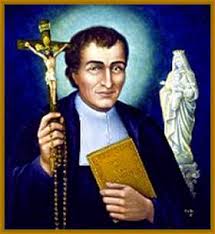 Louis Marie Grignion was born in the hamlet of Montfort, a Breton village about thirteen miles east of Rennes, on 31 January 1673. Later, as an itinerant preacher, he preferred to drop his surname and be called simply Louis Marie de Montfort, or le Pére de Montfort, the Father from Montfort. The second of eighteen children, Louis was one of the few who survived to adulthood. He was born into a family of deep Catholic faith, in an area of France renowned for its dynamic Christian life.
Louis Marie Grignion was born in the hamlet of Montfort, a Breton village about thirteen miles east of Rennes, on 31 January 1673. Later, as an itinerant preacher, he preferred to drop his surname and be called simply Louis Marie de Montfort, or le Pére de Montfort, the Father from Montfort. The second of eighteen children, Louis was one of the few who survived to adulthood. He was born into a family of deep Catholic faith, in an area of France renowned for its dynamic Christian life.
Jesuit Education
At the age of eleven, Louis Marie set out for Rennes, the capital of Brittany, to enrol in the Jesuit College of Thomas à Becket. The young student from Montfort was considered by his teachers to be intelligent, religious, artistic in nature and somewhat shy. It was under the guidance of the Jesuits that Louis’s priestly vocation matured. The decision to enter the priesthood was made, so he tells us, at the Shrine of Our Lady in the Carmelite Church in Rennes. After eight years at the Jesuit College, Louis Marie decided to pursue his theological studies at Saint Sulpice in Paris. At the age of nineteen, a new chapter opened in his life. The young man bade farewell to family and friends at the bridge of Cess on the outskirts of Rennes.
Studies in Paris
Having left all, he crossed the Cesson bridge to a new life of total dependence upon Divine Providence. So convinced was he that God was truly his loving Father that he gave his money, baggage and clothes to the first beggars he met. Begging for food and shelter along the way, he walked to Paris, arriving in the rags of a mendicant.
For the first two years, Montfort attended classes at the Sorbonne. The following six years of theological study, however, were spent under the tutelage of the Sulpicians themselves. Like the Jesuits, they found the student from Montfort to be a talented man of deep faith, intensely studious and strongly devoted to Our Lady. He was notable for the practical love he showed for the poor, for his desire to serve the outcasts of Paris society, and for a determination to live the gospel by identifying with the most neglected.
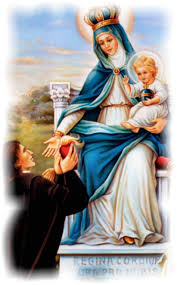 A man of the Bible
A man of the Bible
All his life, but especially as a seminarian, Montfort was an avid reader, and thoroughly enjoyed his task as librarian at Saint Sulpice. Above all else, he was a man of the Bible. The Sacred Scriptures were his constant companion, and his sermons and writings – five major works in all – abound with biblical texts. Louis yearned to proclaim the Good News of God’s love to the outcasts, to assure them of the love of Jesus and of the maternal care of Mary.
First Mass
At the Lady Chapel in the parish church of Saint Sulpice, Father Louis Marie Grignion celebrated his first Mass on 5 June 1700. From the age of eleven, he had completed sixteen years of formal study to reach this goal. Yet Montfort’s priestly ministry itself would last only a further sixteen years.
Unsettled
After a few years of preaching parish renewals and ministering to the destitute at the poor-house at Poitiers, Louis Mary was far from settled. He found it extremely difficult to discover how to implement his belief that God was calling him to serve the poor and to identify with them.
Meeting the Pope
His solution was simple. This unknown young priest from western France would seek the advice of the Pope. And so he set out on foot from Poitiers, begging for food and shelter along the arduous and dangerous routes to the Holy City.
In June 1706, Montfort met with Pope Clement XI (Giovanni Fancesco Albani 1700-21), pouring out his heart to the Vicar of Christ. Strangely, the Holy Father clearly saw in this young priest extraordinary gifts of God. He turned down Louis Marie’s offer to proclaim the gospel in the wilds of Canada or in the Far East. Rather, the Pope named him Apostolic Missionary, telling him to return to his native land and renew the Church there.
He spent the rest of his life conducting approximately two hundred missions and retreats throughout the villages and towns of western France, proclaiming the gospel of God’s love with Spirit-filled power.
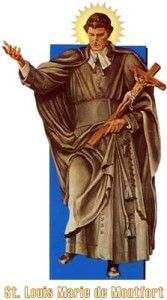 Mixed Reaction
Mixed Reaction
De Montfort’s bold, charismatic proclamation of God’s love was heard in churches, barracks, poor-houses, and even in houses of prostitution. His preaching was a source of admiration for many, of resentment and, sadly, anger for others.
His life-style as a poor, vagabond preacher, with a knapsack strung across his shoulder to carry his Bible, breviary and notebooks, was not considered dignified for a cleric. Several times the episcopal authorities forbade him to preach in one diocese or another. Always obedient, Montfort would move on.
Identified with the poor
With utter disdain for human respect, this saintly man identified with the poor, and found his greatest joy in opening for them the Word of God and offering them whatever material help he could locate. Typical of his actions was the event recorded in Dinan – probably one of many similar acts on his part – when the missionary tenderly embraced a dying, leprous beggar lying in the street, and carried him to a nearby religious house, crying out to the doorkeeper: ‘Open up to Jesus Christ!’
To the majority of the people, Father Louis Marie was simply the Good Father from Montfort. At times he was named the Father with the Big Rosary, for he ordinarily had a large rosary attached to the cord-like belt of his cassock.
Attracting Thousands
His preaching, flowing from his own experience of God’s love and Mary’s maternal care, attracted thousands back to the faith. In a Jansenistic age which harshly stressed the distance between God and his people, he recommended even daily communion, a tender devotion to the Mother of God, and a total surrender to Jesus in Mary.
Undeterred
Because of the style and contents of his preaching, this Elijah-like prophet was regarded by quite a few as no more than a strange misfit. He was poisoned on one occasion and, although it did not prove fatal, it caused his health to deteriorate even more rapidly. Other attempts were made on his life, yet Montfort was not deterred.
‘Slaves of Jesus Christ’
His writings call for a loving, formal acceptance of who we truly are: the slaves of Jesus Christ. The term ‘slave’ always had, for Montfort, the evangelical connotation that we belong to the Lord, that we are loved by him, and that we are redeemed by the Incarnation and total offering of the Incarnate Wisdom for us.
This article first appeared in The Messenger (May 2006), a publication of the Irish Jesuits.
Summary: St Peter Chanel ,the first Marist missionary priest and martyr in Oceania. He spent four years working on the Island of Futuna near Tonga. Chanel College, a second level college in Coolock village, Co Dublin, is called after him.
Patrick Duffy tells his story.
Youth
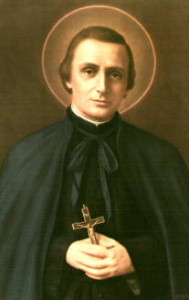 Pierre Louis Marie Chanel was born on July 12, 1803 in the area of Belley in the Rhône-Alpes region of France. After training at minor and major seminaries he was ordained in 1827 and spent a brief time as an assistant priest at Ambérieu, where he met Claude Bret who was to become his friend and also one of the first Marist Missionaries.
Pierre Louis Marie Chanel was born on July 12, 1803 in the area of Belley in the Rhône-Alpes region of France. After training at minor and major seminaries he was ordained in 1827 and spent a brief time as an assistant priest at Ambérieu, where he met Claude Bret who was to become his friend and also one of the first Marist Missionaries.
Early ministry
From an early age he had been thinking about going on the foreign missions and his intention was strengthened by letters that arrived at Ambérieu from a former curate, then a missionary in India. Pierre applied to the bishop of Belley to go to the missions, but was appointed instead for the next three years as parish priest of Crozet, where his zeal and care for ths sick won the hearts of the locals. During this time he heard of a group of diocesan priests who were hopeful of starting a religious order to be dedicated to Mary, the mother of Jesus.
Marist
In 1831, Pierre joined the forming Society of Mary (Marists), who worked both on local and foreign missions. He was appointed first as spiritual director at the Seminary of Belley, where he stayed for five years. In 1833 he accompanied Fr Jean-Claude Colin to Rome to seek papal approval of the growing Society.
Missionary to Oceania
In 1836 the Marists were formally approved by Pope Gregory XVI and were asked to send missionaries to the territory of the South West Pacific. Chanel, professed a Marist on 24th September 1836, was made the superior of a band of Marist missionaries that set out on 24th December from Le Havre. They were accompanied by Bishop Jean Baptiste Pompallier who was to become the first Bishop of New Zealand. Pompallier had been appointed by Gregory XVI to care for the Vicariate Apostolic of Western Oceania. Pompallier based himself in New Zealand from 1838 and became the first Bishop of Auckland, New Zealand in 1848.
Journey
Their first port of call was the Canary Islands. Crossing over to South America, his friend Fr Claude Bret died at sea from a flu virus. By June they reached Valparaiso (where the French Picpus Fathers who had care of the Vicariate of Eastern Oceania had their base). By September they had reached Gambier, then Tahiti, where the group transferred to another ship and set sail for Tonga before first dropping two missionaries at Uvea (also named Wallis), the mainseat of the mission. Pierre Chanel went to neighbouring Futuna Island, accompanied by a French laybrother Marie-Nizier Delorme. They arrived on 8 November 1837 with an English Protestant layman named Thomas Boag who had been resident on the island and had joined them at Tonga seeking passage to Futuna.
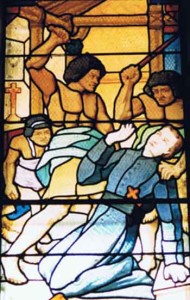 Martyrdom
Martyrdom
The group was initially well received by the island’s king, Niuliki. Once the missionaries learned the local language and began preaching directly to the people, the king grew uneasy, suspecting that Christianity would take away his prerogatives as high priest and king. When his own son, Meitala, sought to be baptized, the king sent a favoured warrior, his son-in-law, Musumusu, to “do whatever was necessary” to resolve the problem. Musumusu initially went to Meitala and the two fought. Musumusu, injured in the fracas, went to Chanel feigning need of medical attention. While Chanel tended him, a group of others ransacked his house. Musumusu took an axe and clubbed Chanel on the head. Peter Chanel died that day, April 28, 1841.
Remains returned to New Zealand and France
News of his death took months to reach the outside world and almost a year before Marists in France learned of it. Bishop Pompallier, upon hearing of the death about six months later, arranged for a French naval corvette L’Allier, commanded by the Comte du Bouzet, to accompany the Mission schooner Sancta Maria and sail on 19 November for Wallis and Futuna Islands, taking with him Fr. Philippe Viard. The two vessels arrived at Uvea (Wallis) on 30 December 1841. They were able to locate and identify his remains, which were brought first to New Zealand in 1842 and eventually in 1850 to the Mother House of the Society of Mary in Lyon.
Veneration and canonisation
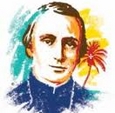 Eventually most on the island, including the chief Musumusu converted to Catholicism. Chanel was declared a martyr and beatified in 1889. He was canonised in 1954 by Pope Pius XII. His feast day in the Catholic Church is 28th April. The relics were returned to Futuna in 1977.
Eventually most on the island, including the chief Musumusu converted to Catholicism. Chanel was declared a martyr and beatified in 1889. He was canonised in 1954 by Pope Pius XII. His feast day in the Catholic Church is 28th April. The relics were returned to Futuna in 1977.
Summary: St Hugh was abbot of Cluny for sixty years and advisor to nine popes. He was one of the most influential leaders of the Middle Ages. It is important to distinguish him from St Hugh of Lincoln, a Frenchman who came to England about a century later.
Patrick Duffy tells this Hugh’s story.
Of Noble Origin
 The image (right) shows St Hugh of Semur, was elected abbot of Cluny. He was the eldest son of Dalmatius, count of Semur (near Autun) and a relative of several Burgundian noblemen. He became a monk of Cluny in defiance of his father’s wishes in 1040 and four years later was ordained priest.
The image (right) shows St Hugh of Semur, was elected abbot of Cluny. He was the eldest son of Dalmatius, count of Semur (near Autun) and a relative of several Burgundian noblemen. He became a monk of Cluny in defiance of his father’s wishes in 1040 and four years later was ordained priest.
Abbot at Twenty-five
Abbot Odilo (962-1049) appointed him as prior and on Odilo’s death he was elected abbot at twenty-five. As abbot Hugh was influential throughout Europe over the next sixty years. He fought lay investiture, simony, and corruption among the clergy. He was adviser to nine popes, including Popes St Leo IX and St Gregory VII.
Counciler and Papal Legate
He took part in many important events such as the condemnation of Berengarius in 1050, the reforming councils of 1055 and 1060. He was papal legate in Hungary (1051-2), Toulouse (1062 and 1068) and Spain (1073). As the godfather of the emperor Henry IV, he also played a role as a mediator during the conflict between Gregory VII and Henry IV, though he was not successful.
The Largest Church in Christendom
During his time a new huge church and monastery were built at Cluny with funds from Kings Ferdinand I and Alphonso VI of Leon and Castile. The church was the largest in Christendom and was consecrated in 1093 by Pope Urban II, who had been prior at Cluny under Hugh.
Foundation in England
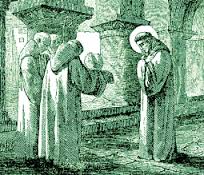 In 1078 Hugh sent monks to begin the foundation of the priory of St Pancras at Lewes in Sussex, England and later was an adviser to St Anselm of Canterbury.
In 1078 Hugh sent monks to begin the foundation of the priory of St Pancras at Lewes in Sussex, England and later was an adviser to St Anselm of Canterbury.
First Crusade (1095)
With Pope Urban II Hugh also helped initiate the first crusade at the council of Clermont (1095).
Canonisation
Pope St Callistus II canonised Hugh in 1120.





















